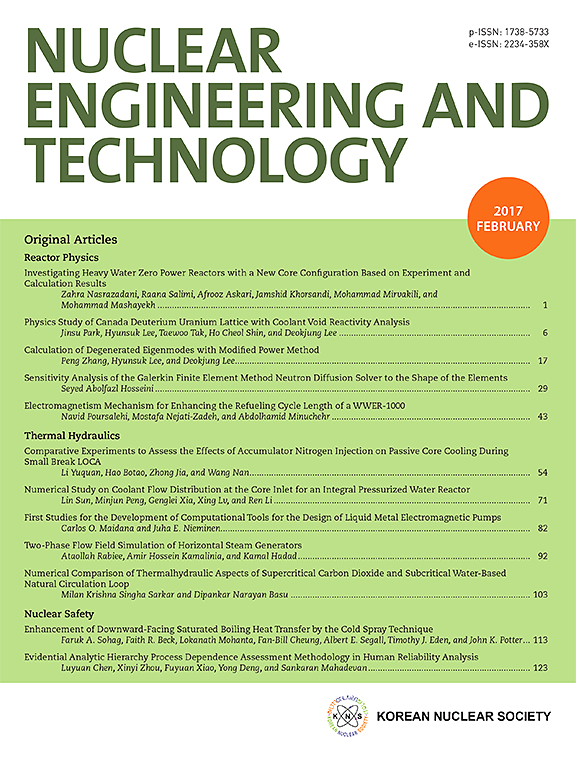Application of DeepONet to predict transient drop motion of the control rod in real-time
IF 2.6
3区 工程技术
Q1 NUCLEAR SCIENCE & TECHNOLOGY
引用次数: 0
Abstract
This paper proposes a surrogate model using a deep operator neural network (DeepONet) to predict transient drop motion of CR in real-time. The DeepONet model is trained using synthetic data obtained from the experimentally verified flexible multibody dynamic model, which considers large deformation, fluid-structure interaction, and friction. In the DeepONet architecture, the branch network processes the deformation profile of the fuel assembly (FA), while the trunk network handles the three actuator strokes as structural parameters along with time, enabling the model to predict the displacement and velocity of the CR. The accuracy of DeepONet is evaluated by calculating the mean absolute error of the normalized output, and the model's efficiency is assessed by comparing the computational time of the flexible multibody dynamics model with that of the DeepONet. Validation results demonstrate strong agreement between the DeepONet predictions and those of the flexible multibody dynamics model, achieving 99.39 % accuracy for displacement and 98.72 % accuracy for velocity under various FA deformations. Furthermore, the DeepONet provides a computational speedup of over 1500 times, with average prediction times of 321.4 ms. The proposed surrogate model offers a reliable solution for predicting CR drop motion with high accuracy and computational efficiency, enhancing nuclear reactor safety.
应用DeepONet实时预测控制杆的瞬态下落运动
本文提出了一种基于深度算子神经网络(DeepONet)的替代模型来实时预测CR的瞬态跌落运动。DeepONet模型是使用从实验验证的柔性多体动力学模型中获得的综合数据进行训练的,该模型考虑了大变形、流固耦合和摩擦。在DeepONet体系结构中,分支网络处理燃油组件(FA)的变形轮廓,主干网络处理执行器的三个行程作为随时间变化的结构参数,使模型能够预测CR的位移和速度。并通过比较柔性多体动力学模型与DeepONet模型的计算时间来评价模型的有效性。验证结果表明,DeepONet预测结果与柔性多体动力学模型的预测结果非常吻合,在各种FA变形下,位移精度达到99.39%,速度精度达到98.72%。此外,DeepONet提供了超过1500倍的计算加速,平均预测时间为321.4 ms。该模型为预测CR下落运动提供了可靠的解决方案,具有较高的精度和计算效率,提高了核反应堆的安全性。
本文章由计算机程序翻译,如有差异,请以英文原文为准。
求助全文
约1分钟内获得全文
求助全文
来源期刊

Nuclear Engineering and Technology
工程技术-核科学技术
CiteScore
4.80
自引率
7.40%
发文量
431
审稿时长
3.5 months
期刊介绍:
Nuclear Engineering and Technology (NET), an international journal of the Korean Nuclear Society (KNS), publishes peer-reviewed papers on original research, ideas and developments in all areas of the field of nuclear science and technology. NET bimonthly publishes original articles, reviews, and technical notes. The journal is listed in the Science Citation Index Expanded (SCIE) of Thomson Reuters.
NET covers all fields for peaceful utilization of nuclear energy and radiation as follows:
1) Reactor Physics
2) Thermal Hydraulics
3) Nuclear Safety
4) Nuclear I&C
5) Nuclear Physics, Fusion, and Laser Technology
6) Nuclear Fuel Cycle and Radioactive Waste Management
7) Nuclear Fuel and Reactor Materials
8) Radiation Application
9) Radiation Protection
10) Nuclear Structural Analysis and Plant Management & Maintenance
11) Nuclear Policy, Economics, and Human Resource Development
 求助内容:
求助内容: 应助结果提醒方式:
应助结果提醒方式:


